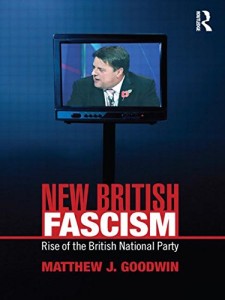Who joins the BNP and who votes BNP?
Matthew Goodwin’s book New British Fascism: Rise of the British National Party, expands on one of his previous works on political extremism, this time looking in-depth at just the BNP.
New British Fascism: Rise of the British National Party has at its heart an impressively extensive set of interviews with BNP members. Goodwin’s conclusion is a nuanced one – that the BNP has carved out a strong base in a narrow niche, meaning both that it is not likely to disappear any time soon nor is it likely to break through to major levels of support. Subsequent events, however, suggest that he overplayed its likely long-term strength as the BNP disappeared downwards in a spiral of failure and infighting.
That BNP base at the time Goodwin was doing his research was made up of “supporters who are socially distinct and deeply concerned about a specific set of issues”, primarily “angry white men: middle-aged and elderly working-class men who typically have few educational qualifications and are deeply pessimistic about their economic prospects”. Unlike predecessor parties in the 1970s, it is anti-Muslim rather than anti-black sentiment which features most strongly and concerns about the cultural direction of the country are prominent.
As Goodwin points out, the success of a political party is dependent on both the “demand side” (the wider political context in which it operates) and the “supply side” (its own organisation and ability to make its own political weather). The BNP’s rise has seen it attract voters on the basis of both hostility towards immigration and political dissatisfaction – the combination being “the most important predictors of whether somebody will vote BNP”.
The post-2010 general election troubles of the BNP showed how their level of support limited, but also showed how due to their failings on the “supply side” the BNP would indeed fall back into that irrelevance which was their home for many years.
That subsequent fall was hastened by other parties learning the lesson of the BNP’s rise, with its effective tactics that Goodwin documents of getting stuck into local community issues which other parties take up in many areas but were neglecting where the BNP got stuck in. In that they will be helped by the age factor Goodman points out: “the BNP’s attempt to widen its appeal among young people has met little success”. Added to that is the widespread opposition to the BNP due to abhorrence of its views to most people on race and toleration.
Goodwin’s book is both a good example of how detailed investigation of a minor party can reveal much new about the sources of its support and motivations of its members, and also an extremely useful background guide for anyone wanting to fight elections successfully against the BNP.
If you like this, you might also be interested in The new extremism in 21st century Britain.
Got a view on this review? Then please rate it on Amazon.
Buy New British Fascism: Rise of the British National Party by Matthew Goodwin here.

Leave a Reply